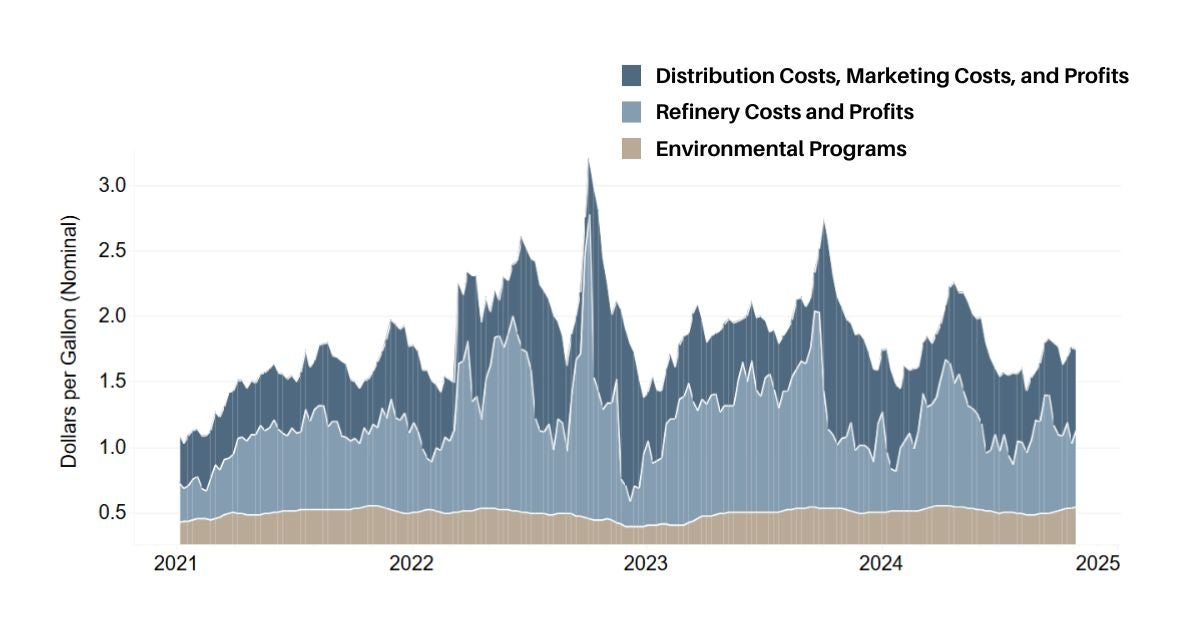Fear, uncertainty and doubt are frequently-used tools to undermine environmental policy. For decades, polluters and their sympathizers rejected the existence of climate change. Now, they say climate action costs too much. This recurring argument ignores the costs working Californians are already facing from a changing climate and the clear benefits of California’s climate policy in order to justify “business as usual” for the biggest polluters.
Californians rightly want to understand fluctuations in day-to-day energy prices, but debates over these issues cannot conveniently ignore the significant costs of climate inaction, its impact on our cost of living and its disproportionate impact on families with low incomes.
- A national report ranked California the worst state for natural disasters fueled by a changing climate, with expected annual losses totaling more than $16 billion statewide
- Home insurance is harder and more expensive to get. Seven of California’s largest property insurers, State Farm, Allstate, Farmers, USAA, Travelers, Nationwide and Chubb recently limited new homeowners policies in the Golden State — raising questions about the stability of the California home insurance market.
- During an 11-year period, exposure to wildfire smoke caused more than 50,000 deaths in California and more than $400 billion in economic impacts.
- During seven extreme heat events over the past decade, California experienced $7.7 billion in losses.
Gas prices are shaped by the oil business, not climate policy
After two special legislative sessions on gas prices, we know there are a lot of factors that go into what we pay at the pump. But data collected by the California Energy Commission clearly shows that oil industry profits and costs have gone up significantly while environmental program costs from the Low Carbon Fuel Standard (LCFS) and cap-and-trade have been very consistent.
This chart from the California Energy Commission clearly shows company decisions shaping the cost to refine, market and distribute gasoline have a much bigger impact on gas prices, along with their profit margins. Specifically, the cost of compliance with environmental programs is essentially flat while oil industry revenue is increasing. If, like many Californians, you are concerned about gas prices, then LCFS and cap-and-trade are not to blame.
Climate programs are helping Californians save money
Based on the polluter pays principle, California’s cap-and-trade program has generated billions of dollars in revenue for climate action. The 2024 California Climate Investments annual report cites almost $28 billion in appropriations from the State Legislature, including $3.8 billion in 2023 alone. This revenue is derived from the state’s limit on climate pollution and price per ton of greenhouse gas emissions. These dollars have been invested in myriad programs to lower energy costs for working Californians, including:
- Funding Agricultural Replacement Measures for Emission Reductions (FARMER) provides incentives for cleaner harvesting equipment, tractors, and other necessary equipment. Almost $420 million has been allocated to this program to help growers upgrade their equipment to cleaner, more efficient models. 80 percent of program funding is directed to the San Joaquin Valley Air Pollution Control District, which has the highest overlap of farmland and disadvantaged and low-income communities.
- Energy efficiency programs for low-income multi-family housing and farmworker housing provide incentives or direct installation of energy efficiency upgrades, solar power, or solar water heating. With almost $130 million dedicated to date, these measures help some of California’s most vulnerable residents reduce their energy costs.
- Equitable Building Decarbonization (EBD) is a new program but has been a high priority for environmental justice advocates. EBD will provide funding for incentives and direct installation of new technology and retrofits to low-income households to improve their energy efficiency, reduce energy costs, and help maintain a safe and comfortable indoor environment. The state budget pledges over $500 million for this program over the next three years, paid for with cap-and-trade revenue.
- The California Climate Credit provides most Californians a twice-a-year credit on their utility bill. This is revenue from cap-and-trade that is directly returned to ratepayers. Since 2014, over $13.5 billion has been sent back to households and small businesses on their energy bill.
Climate programs are helping working Californians transition away from fossil fuels
In addition to providing financial and public health benefits, California’s climate programs are enabling all residents to transition away from our dependence on fossil fuels.
- Clean Cars 4 All — Cap-and-trade revenue is paying for low-income drivers to retire old, dirty, gas-guzzling vehicles with newer and more efficient hybrid or electric vehicles. Over $230 million has been allocated to this program, resulting in over 3 million gallons of reduced gasoline demand.
- Zero-Emission Vehicle Infrastructure Crediting — The Low Carbon Fuel Standard is a key funding source for electric vehicle infrastructure, which makes it easier for drivers to rely on electric vehicles and not fossil fuels. Over 4,400 fast chargers across over 700 sites in California have been funded by LCFS credits. As the stringency of the LCFS increases over time, and CARB’s zero-emission vehicle rules are implemented, the expectation is that electrification credits increase significantly — further supporting the transition away from internal combustion engines.
- Clean Technology Rebates — The LCFS has also funded investments for individual drivers through their utility bill including rebates on the purchase of electric or hybrid vehicles, including pre-owned vehicles and at-home charging. For example, Southern California Edison is spending approximately $224 million of LCFS on vehicle electrification, with 86% dedicated to disadvantaged communities.
As we forge the transition away from our dependence on fossil fuels, we must be guided by science, clarity on the urgency to act and transparency. This is how we maintain the credibility of our policies that serve as a model for the world to follow and build the political will to maintain them to completion. We may not get everything right along the way but we know we fail if we lose our resolve for climate action. Our challenge is to learn and adapt based on the facts, and to ask if there is more we should be doing — not to lose our way when climate deniers and big polluters cry foul.
Some things are certain. The climate threats facing California families and taxpayers today will only get more frequent and destructive, and they will disproportionately impact the most vulnerable among us.











